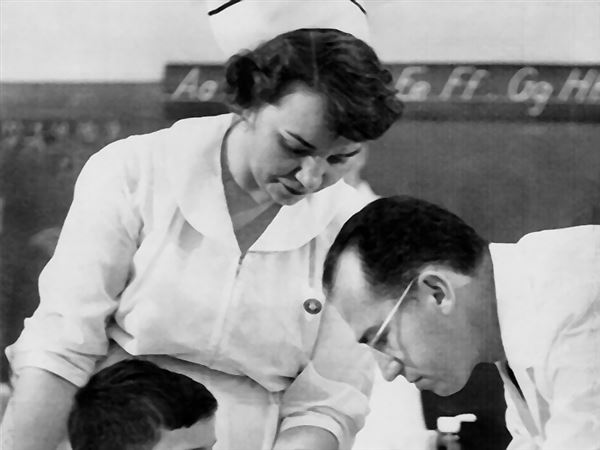She’s not to everyone’s taste. Tuesday was the 100th birthday of the writer Flannery O’Connor. She’s got her own volume in the Library of America series, the writer’s equivalent of the Hall of Fame, but you’re more likely to read her in a classroom than a book club.
Her stories appeared not only in the more literary magazines, but in places like The Atlantic, Harper’s Bazaar, Esquire and Mademoiselle. Her two novels and 31 short stories are rough and grim, though also often very funny, with what many will think too dark a view of human nature.
Many readers at the time didn’t like them. “Some old lady said that my book left a bad taste in her mouth,” she told an interviewer. “I wrote back to her and said, ‘You weren’t supposed to eat it.’”
Meeting the Misfit
I want to argue for reading O’Connor, not least because she can complicate our understanding of human nature, which for many of us is sometimes too dark and sometimes too sunny, and selective. Hers was simultaneously dark and sunny, and universal.
O’Connor grew up and spent most of her short life on her mother’s farm in Milledgeville, Ga., then a small rural town about 90 miles southwest of Atlanta. (A town known to Pittsburghers for an incident early in Ben Rothlisberger’s career.)
She went to the University of Iowa’s Writer’s Workshop, then the farm league for future Hall of Famers, where her gifts were recognized. Diagnosed in 1952 with lupus, which had killed her father when she was 16, she returned home and made her way as a writer while battling the disease. She died of lupus in 1964, at the age of 39.
She wrote one of her best known stories, “A Good Man is Hard to Find,” in 1953 at the beginning of her career. It begins as a family car trip comedy, with ill-behaved children, a manipulative grandmother and a father who starts the trip ticked off. The first few pages are very funny, at least to fathers who have driven their families on car trips.
The humor’s mostly observational and dry. For example: the grandmother “had on a navy blue straw sailor hat with a bunch of white violets on the brim and a navy blue dress with a small white dot in the print. Her collars and cuffs were white organdy trimmed with lace. ... In case of an accident, anyone seeing her dead on the highway would know at once that she was a lady.”
She sealed their fate
The grandmother lies to the children to get them to force their father to detour to a plantation house she remembered visiting as a child, and then too late remembers the place she wanted to see was in a different state (a fact she did not mention to anyone). The story ends, thanks to another of the grandmother’s deceptions, with the car rolling off the road and the family murdered by a serial killer called “The Misfit.”
The grandmother seals their fate by recognizing him. He still tries to comfort her after her son “said something to her that shocked even the children.” She tries to tell him he’s really a good man who won’t kill an old lady. “Listen, I know you’re a good man. You don’t look a bit like you have common blood. I know you must come from nice people!”
The grandmother finally turns to religion, begging him to pray, even as he tells his two companions to take her family into the woods and shoot them. He turns out to be a philosophical man and over four or five pages the Misfit and the grandmother have a theological argument about why he is the way he is, he arguing that he would have been a good man if he knew whether God exists, blaming God for not giving him any evidence. The Misfit is much the better theologian.
The argument ends suddenly. “She saw the man’s face twisted close to her own as if he were going to cry and she murmured, ‘Why you’re one of my babies. You’re one of my own children!’ She reached out and touched him on the shoulder. The Misfit sprang back as if a snake had bitten him and shot her three times through the chest.”
Then he says the story’s most famous line: “She would of been a good woman, if it had been somebody there to shoot her every minute of her life.”
Complicated characters
It seems, I admit, a completely dark story that proves other people are as bad as we can think they are. But it isn’t.
The grandmother, the character whose development forms the story, confused being respectable with being good, as many people do, and used rather than believed her religion, as many religious people do. She found that her forms of both did her no good.
She is morally mediocre, lady though she thought herself. Her sins, though petty and banal, still get her family killed. She’s thoroughly dislikable. Yet she proves — though only under threat of death — capable of recognizing herself in someone as evil as the Misfit, to see him as someone like herself — and worse, the product of her own life. She can show even the Misfit, who’d murdered her family, compassion for his being the man he is. She is, as we say now, complicated.
And so was the Misfit. He half-wants to be good, wants it enough to feel angry that he doesn’t know if the universe is moral or not, so he’d know whether to be moral or not. He might have let the grandmother live if she hadn’t touched him. He is not wholly gone and there remains some tiny hope he may change.
“A Good Man is Hard to Find” is a simpler story than most of her later ones, which complicate matters even more subtly. And there’s much more to her writing than that. Please do read her.
David Mills’ previous column was “How to act when so many flaunt their cruelty.” Adriana Ramírez also wrote on Flannery O’Connor in “The Unfinished Work of Flannery O’Connor.”
First Published: March 26, 2025, 11:42 p.m.
Updated: March 27, 2025, 3:00 a.m.
















